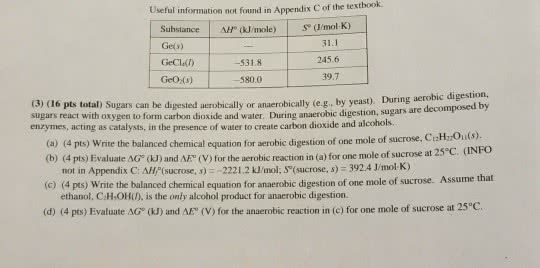(1) Sugars can be digested aerobically (with oxygen) or anaerobically (e.g., by yeast). During aerobic digestion, sugars react with oxygen to form carbon dioxide and water. During anaerobic digestion, sugars can be decomposed by enzymes to create carbon dioxide and alcohols.
(a) Write the balanced chemical equation for aerobic digestion of glucose. C6H12O6(s). Identify the oxidizing and reducing agents in this reaction.
(b) Evaluate the number of moles of electrons transferred for the aerobic reaction in (a) for one mole of glucose at 25 degrees celcius.
(c) Write the balanced chemical equation for anaerobic digestion of glucose. Assume that ethanol, C2H5OH(l), is the only alcohol product for anaerobic digestion. Identify the oxidizing and reducing agents in this reaction.
(d) Evaluate the number of moles of electrons transferred for the anaerobic reaction in (c) for one mole of glucose at 25 degrees celcius.
(2) Aqueous nitrous acid disproportionates into nitric acid and nitric oxide gas under standard conditions at 25 degrees celcius.
(a) Write the balanced chemical equation for this reaction using smallest whole number coefficients.
(b) Explain what is meant by the verb âdisproportionates.â
(c) Evaluate delta E*ï° (V) for the reaction in (a). The standard reduction potential between aqueous
nitric acid and nitrous acid is +0.94 V.
(3) Active metals like zinc will react with concentrated nitric acid to produce the ammonium ion
and the Zn2+(aq) ion at 25 degrees celcius.
(a) Write the balanced chemical equation for this process using smallest whole number coefficients.
(b) Evaluate delta E* (V) for the reaction in (a). The standard reduction potential between nitric acid and the ammonium ion is +0.89 V.
(4) Less active metals like copper will react with concentrated nitric acid to produce nitric oxide gas and the Cu2+(aq) ion at 25 degrees celcius.
(a) Write the balanced chemical equation for this process using smallest whole number coefficients.
(b) Evaluate delta E*ï° for the reaction in (a).
(1) Sugars can be digested aerobically (with oxygen) or anaerobically (e.g., by yeast). During aerobic digestion, sugars react with oxygen to form carbon dioxide and water. During anaerobic digestion, sugars can be decomposed by enzymes to create carbon dioxide and alcohols.
(a) Write the balanced chemical equation for aerobic digestion of glucose. C6H12O6(s). Identify the oxidizing and reducing agents in this reaction.
(b) Evaluate the number of moles of electrons transferred for the aerobic reaction in (a) for one mole of glucose at 25 degrees celcius.
(c) Write the balanced chemical equation for anaerobic digestion of glucose. Assume that ethanol, C2H5OH(l), is the only alcohol product for anaerobic digestion. Identify the oxidizing and reducing agents in this reaction.
(d) Evaluate the number of moles of electrons transferred for the anaerobic reaction in (c) for one mole of glucose at 25 degrees celcius.
(2) Aqueous nitrous acid disproportionates into nitric acid and nitric oxide gas under standard conditions at 25 degrees celcius.
(a) Write the balanced chemical equation for this reaction using smallest whole number coefficients.
(b) Explain what is meant by the verb âdisproportionates.â
(c) Evaluate delta E*ï° (V) for the reaction in (a). The standard reduction potential between aqueous
nitric acid and nitrous acid is +0.94 V.
(3) Active metals like zinc will react with concentrated nitric acid to produce the ammonium ion
and the Zn2+(aq) ion at 25 degrees celcius.
(a) Write the balanced chemical equation for this process using smallest whole number coefficients.
(b) Evaluate delta E* (V) for the reaction in (a). The standard reduction potential between nitric acid and the ammonium ion is +0.89 V.
(4) Less active metals like copper will react with concentrated nitric acid to produce nitric oxide gas and the Cu2+(aq) ion at 25 degrees celcius.
(a) Write the balanced chemical equation for this process using smallest whole number coefficients.
(b) Evaluate delta E*ï° for the reaction in (a).

